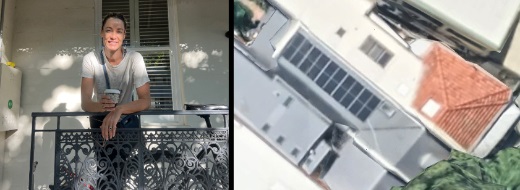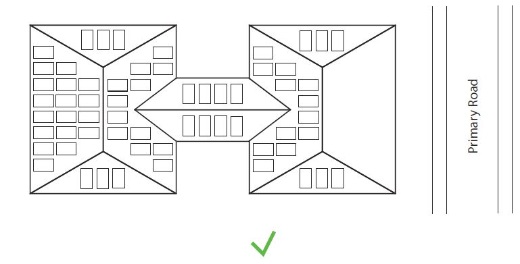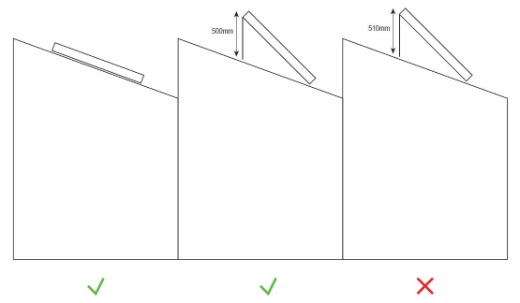Solar in Heritage Conservation Areas
Woollahra Council encourages the installation of rooftop solar systems, including sensitive installation in heritage conservation areas. Residents are sometimes unsure if they can install solar when they live in a heritage area. It is often possible, but you may require approval.
To help you apply and confirm what's needed we've created a simplified application pathway using our Heritage Works Without Consent Form that can be used in many cases. In some circumstances this will not be sufficient and you may need to submit a Development Application (DA).
Remember to check approval requirements, and where necessary apply for approval, before you commence any work on your project.
You'll find further details below.

Paddington resident: "We are really pleased with the number of panels we were able to install despite our narrow roof."
Approval requirements
- Exempt development: some installations of solar energy systems in heritage conservation areas are considered ‘exempt development’, which means you do not need to get approval from Council. You will find full details of these requirements in Section 2.41(4) of State Environmental Planning Policy (Transport and Infrastructure) 2021.
- Council approval: if your proposal does not meet the 'exempt development' criteria, or if you are unsure, read the information below to determine which of the following two pathways is best for you to apply.
- Heritage Works Without Consent Form
- Development Application (DA)
Note: when you need Council approval you cannot commence works until you receive a response to your application.
1. You can use the Heritage Works without Consent Form to apply when
- You wish to install a rooftop solar system on a property that is a local heritage item or in a heritage conservation area.
- Works are deemed to be of a minor nature that will not affect the heritage significance of heritage items or contributory properties in heritage conservation areas.
- Proposed works have not yet commenced.
What are the requirements for our system to be approved under the Heritage Works without Consent Guideline?
Your Heritage Works Without Consent application for solar panels will most likely be approved under this Guideline if it meets the following requirements:
- Location: solar panels must be located on the rear slopes of roofs (see Figure 1). They should be located at least 300mm from the ridge(s) of the roof. They should not be located on dormer roofs. (see Figure 2)
- Alignment: on sloped roofs, solar panels must be parallel to the lower edge of the roof plane. (see Figure 2)
- Projection: solar panels must not extend over the edges of the roof plane. The solar panel should not project more than 500mm from the surface of the roof in any direction, at any point. Ideally, solar panels on sloping roofs will be parallel with the slope. (See Figure 3)
- Pattern: solar panels must be arranged in orderly rows with consistent offset from the roof edges (see Figure 2)
- Pattern: solar panels on roof planes containing parapets, dormer windows, skylights and chimneys, and that are visible from the public domain (including the harbour), should be arranged in a symmetrical pattern, as far as possible, on the roof plane.
- Visibility: the visibility of associated equipment such as conduit, mounting rails and clips should be reduced as much as possible – not protruding from under the panels.

Figure 1: no panels on roof plane facing primary road

Figure 2: panel alignment, location and pattern

Figure 3 - panels should not project more than 500mm
Related equipment on walls:
- Location: equipment associated with a solar energy system, other than solar panels, may be installed on building walls that do not face the primary road. They should not cover windows and should avoid decorative features.
- Fixing methods: penetrations to stone or brick walls required for fixings should be made in the mortar joints, rather than into brick or stone itself.
Other Considerations
- It is the applicant’s responsibility to make sure that all building works are carried out in accordance with applicable legislation and codes.
- Applicants are strongly encouraged to consider providing clear access paths around solar panels to allow for roof maintenance. A setback of 300mm from the edge of the roof and obstructions is recommended.
- There is no limit on how much of a roof may be covered by solar panels, except as noted in this guideline.
- Applicants are encouraged to use solar panels that have a design that is visually recessive (i.e. less noticeable) in terms of colour and pattern. For example, entirely dark grey/black solar panels are preferred to those with silver banding.
- In some instances, there will be a risk that future nearby development will result in overshadowing of solar panels. To minimise this risk, owners are encouraged to check the planning controls that apply to surrounding land when considering the location of solar panels.
Note: Please read all the FAQs below so you understand the application process, definitions and requirements for your application to be approved.
Apply here
2. Development Application (DA)
If any of the following apply you will need to submit a DA. You cannot use the Heritage Works without Consent Form in these cases.
- Use of photovoltaic tiles. Photovoltaic tiles are different to standard solar panels as they replace the existing roof tiles or cladding and therefore may need a DA.
- Installing a ground-mounted system. Please submit a DA for ground-mounted solar energy systems that do not meet the criteria for exempt development outlined in the Transport and Infrastructure SEPP 2021.
- Other limitations requiring a DA
- The proposed works require structural alterations.
- The solar energy systems are proposed on slate or timber shingled roofs, which require special fixings and may necessitate structural alterations. Such roofs may still be eligible for an exemption, but these issues must be addressed in your application.
- The proposed works require the removal of roof coverings or elements such as chimneys, capping or parapet walls.
- In rare cases, individual heritage items (distinct from other buildings in heritage conservation areas) may be exceptional owing to their design or materiality. If you are the owner of a heritage item, it is recommended that you follow this guide and submit the Heritage Works without Consent Form. In the unlikely event that your property is not suitable for an exemption, Council staff will contact you to discuss other options.
Note: If you decide to submit a DA, your works should adhere to the "requirements for a system to be approved" (see FAQs) as closely as possible. Your application should provide as much information as possible about the proposed works and why the system complying with this Guideline was not possible. If your system does not comply with this Guideline, please clearly explain the reasons.
State-listed items. If you are the owner of a State-listed heritage item, you may require approval from Heritage NSW for the installation of solar panels. See Heritage NSW for more details.
Submit a DA
Our most common question
Can we put panels on the roof plane facing the road?
Systems facing a primary road are not permitted in Heritage Conservation Areas and will not be approved. A primary road is the road to which the front of a house (or main building) faces. This is usually the road referenced in the property address. See full definition in FAQs below.

FAQs
Please read all the FAQs below so you understand the application process, fee waivers and requirements for your application to be approved.
What solar energy system items are covered by this Guideline?
For the purpose of this Guideline, solar energy systems include: rooftop solar panels (photovoltaic electricity generating systems) and associated fixings, conduit, batteries or inverters; solar hot water systems; and solar air heating systems.
What are the requirements for our system to be approved under the Heritage Works without Consent Guideline?
Your Heritage Works Without Consent application for solar panels will most likely be approved under this Guideline if it meets the following requirements:
- Location: solar panels must be located on the rear slopes of roofs (see Figure 1). They should be located at least 300mm from the ridge(s) of the roof. They should not be located on dormer roofs. (see Figure 2)
- Alignment: on sloped roofs, solar panels must be parallel to the lower edge of the roof plane. (see Figure 2)
- Projection: solar panels must not extend over the edges of the roof plane. The solar panel should not project more than 500mm from the surface of the roof in any direction, at any point. Ideally, solar panels on sloping roofs will be parallel with the slope. (See Figure 3)
- Pattern: solar panels must be arranged in orderly rows with consistent offset from the roof edges (see Figure 2)
- Pattern: solar panels on roof planes containing parapets, dormer windows, skylights and chimneys, and that are visible from the public domain (including the harbour), should be arranged in a symmetrical pattern, as far as possible, on the roof plane.
- Visibility: the visibility of associated equipment such as conduit, mounting rails and clips should be reduced as much as possible – not protruding from under the panels.

Figure 1: no panels on roof plane facing primary road

Figure 2: panel alignment, location and pattern

Figure 3 - panels should not project more than 500mm
Related equipment on walls:
- Location: equipment associated with a solar energy system, other than solar panels, may be installed on building walls that do not face the primary road. They should not cover windows and should avoid decorative features.
- Fixing methods: penetrations to stone or brick walls required for fixings should be made in the mortar joints, rather than into brick or stone itself.
Other Considerations
- It is the applicant’s responsibility to make sure that all building works are carried out in accordance with applicable legislation and codes.
- Applicants are strongly encouraged to consider providing clear access paths around solar panels to allow for roof maintenance. A setback of 300mm from the edge of the roof and obstructions is recommended.
- There is no limit on how much of a roof may be covered by solar panels, except as noted in this guideline.
- Applicants are encouraged to use solar panels that have a design that is visually recessive (i.e. less noticeable) in terms of colour and pattern. For example, entirely dark grey/black solar panels are preferred to those with silver banding.
- In some instances, there will be a risk that future nearby development will result in overshadowing of solar panels. To minimise this risk, owners are encouraged to check the planning controls that apply to surrounding land when considering the location of solar panels.
How can I check the heritage status of my property?
Visit the mapping page to access tools to view the heritage status of your property, including any heritage conservation areas or heritage listings that may affect it.
Are there any fees?
- The usual fee to submit a Heritage Works Without Consent Form is waived when it relates solely to the installation of solar energy systems.
- The usual fee to submit a DA is waived when it relates solely to the installation of solar energy systems.
What will happen next when I apply?
- When you submit a Heritage Works without Consent Form our Planning Team will check your property’s heritage significance on our mapping and use the information you provide to determine if your works can be approved under this Guideline.
- If you submit a DA, Council will review your application and advise if your works have been approved.
Do I need to wait for a response before installing my solar panels?
Yes, you need to wait for a reply before starting any work. If works commence before this advice is received from Council they may be non-compliant and will not be approved retrospectively. Fines and orders may be incurred for non-compliant works.
What is a primary road when considering where panels can be placed?
A primary road is one which the front of a dwelling house, or a main building, on a lot faces or is proposed to face. Some buildings may have more than one primary road, if they are located on a corner and have a frontage to both roads.
Systems facing a primary road are not permitted in Heritage Conservation Areas. See the full explanation of this in our DCP Chapter E6, Part E6.3 Objective O1, Control C2b states “For buildings in a heritage conservation area and buildings which are local or State heritage items, the solar energy system must meet the following location requirements: … b) Is not placed facing the primary road”.
What is a heritage conservation area?
What is the relevant Council legislation and planning guidance?
Who can I ask for more information?
If you would like to discuss this process please call our Duty Planner on 9391 7000.
More information